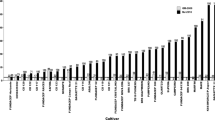Abstract
Wheat streak mosaic virus (WSMV), vectored by the wheat curl mite (WCM),Aceria tosichella Keifer, is one of the most destructive viral diseases of wheat found in many wheat producing areas of the world. Host resistance is the most effective method for controlling this disease and its vector. Symptomatological analysis and enzyme-linked immunosorbent assay (ELISA) were used to characterize WSMV-resistance in wheat-alien partial amphiploid lines and their derivatives. The results showed that most of partial amphiploids derived fromThinopyrum ponticum andTh. intermedium were free of systemic symptoms with very low ELISA readings that were similar to that of the non-inoculated Chinese Spring control. While the partial amphiploid lines 693 and PWM706 were identified as new genetic resources of resistance to WSMV. The present study demonstrated that both symptomatological and ELISA methods efficiently assessed WSMV-resistance in the wheat-alien hybrids and systemic symptom incidence and ELISA absorbance readings were highly correlated (r 2 = 0.8658−0.9323) over time following inoculation. The ELISA results also indicated that the virus did not buildup in the plant tissues of these virus-resistant partial amphiploids. Similar results were observed in chromosome translocation and substitution lines that have the geneWsm1 conferring WSMV resistance. However, the lines containing the geneWsm1 and all the partial amphiploid lines, except Agrotana, were susceptible to the WCM. One line derived from a cross of wheat and Agrotana, was effective in controlling the spread of WSMV and was highly resistant to the WCM. Another line and an accession ofTriticum dicoccoides (Koern.) Schweinf. were highly susceptible to WSMV and WCM. Early disease development was delayed in a new hard red winter cultivar McClintock. The partial WSMV-resistance of McClintock was demonstrated by initially low ELISA readings, and a lower percentage of infected plants than other WSMV-susceptible wheat. The use of the identified promising sources of resistance to WSMV and the WCM in wheat breeding is discussed.
Similar content being viewed by others
References
Andrews J.E. and Slykhuis J.T. 1956. Reaction of winter wheat varieties andTriticum ×Agropyron hybrids when inoculated with wheat streak mosaic virus by the mite vectorAceria tulipae Keifer. Plant Dis. Rep. 40: 513–516.
Atkinson T.G. and Grant M.N. 1967. An evaluation of streak mosaic losses in winter wheat. Phytopathology 57: 188–192.
Bockus W.W., Appel J.A., Bowden R.A., Fritz A.K., Gill B.S., Martin T.J., Sears R.G., Seifers D.L., Brown-Guedira G.L. and Eversmeyer M.G. 2001. Success stories: breeding for wheat disease resistance in Kansas. Plant Dis. 85: 453–461.
Brûlé-Babel, 2001. Request for support for registration of UM5089. In: Graf R.L. and Fox S.L. (eds), Prairie Registration Recommending Committee for Grain: Wheat, Rye and Triticale Subcommittee Report 2001, Saskatoon, SK, pp. 105–110.
Cauderon Y. 1966. Etude cytogénétique de l’évolution du materiel issu de croisements entreTriticum aestivum etAgropyron intermedium. Annales Améliorament des Plantes 16: 43–70.
Cauderon Y., Saigne B. and Dauge M. 1973. The resistance to wheat rusts ofAgropyron intermedium and its use in wheat inprovement. In: Sears E.R. and Sears L.M.S. (eds), Proceedings of the 4th International Wheat Genetics Symposium, University of Missouri, Columbia, Missouri. pp. 401–470.
Chen Q., Conner R.L. and Laroche A. 1995. Identification of the parental chromosomes of the wheat-alien amphiploid Agrotana by genomicin situ hybridization. Genome 38: 1163–1169.
Chen Q., Conner R.L., Laroche A., Fedak G. and Thomas J.B. 1999. Genome origins ofThinopyrum chromosomes specifying resistance to wheat streak mosaic virus and its vector,Aceria tosichella. Genome 42: 289–295.
Chen Q., Conner R.L., Ahmad F., Laroche A., Fedak G. and Thomas J.B. 1998. Molecular characterization of the genome composition of partial amphiploids derived fromTriticum aestivum ×Thinopyrum ponticum andT. aestivum ×Th. intermedium as sources of resistance to wheat streak mosaic virus and its vector,Aceria tosichella. Theor. Appl. Genet. 97: 1–8.
Comeau A., Makkouk K.M., Ahmad F. and St-Pierre C.A. 1994. Bread wheat ×Agrotricum crosses as a source of immunity and resistance to the PAV strain of barley yellow dwarf luteovirus. Agronomie 2: 153–160.
Conner R.L., Thomas J.B. and Whelan E.D.P. 1991. Comparison of WCM resistance for control wheat streak mosaic. Crop Sci. 31: 315–318.
Edwards M.C. and McMullen M.P. 1988. Variation in tolerance to wheat streak mosaic virus among cultivars of hard red spring wheat. Plant Dis. 72: 705–707.
Fedak G., Chen Q., Conner R.L., Laroche A., Petroski R. and Armstrong K.W. 2000. Characterization of wheat-Thinopyrum partial amphiploids by meiotic analysis and genomicin situ hybridization. Genome 43: 712–719.
Gill B.S., Friebe B., Wilson D.L. and Cox T.S. 1995. Registration of KS93WGRC27 wheat streak mosaic virus-resistant T4DL.4Ai#2S wheat germplasm. Crop Sci. 35: 1236–1237.
Harvey T.L., Seifers D.L., Martin T.J., Brown-Guedira G. and Gill B.S. 1999. Survival of wheat curl mites on different sources of resistance in wheat. Crop Sci. 39: 1887–1889.
Harvey T.L., Martin T.J. and Seifers D.L. 1994. Importance of plant resistance to insect and mite vectors in controlling virus diseases of plants: Resistance to the wheat curl mite (Acari: Eriophyidae). J. Agric. Entomol. 11: 271–277.
Jedlinski H., Rochow W.F. and Brown C.M. 1977. Tolerance to barley yellow dwarf virus in oats. Phytopathology 67: 1408–1411.
Larson R.I. and Atkinson T.G. 1973. Wheat-Agropyron chromosome substitution lines as sources of resistance to wheat streak mosaic virus and its vector,Aceria tulipae. In: Sears E.R. and Sears L.M.S. (eds), Proceedings of the 4th International Wheat Genetics Symposium, University of Missouri, Columbia, MO, pp. 173–177.
Li H.J., Conner R.L., Chen Q., Jia X., Li H., Graf R.J., Laroche A. and Kuzyk A.D. 2003. Different reactions to wheat curl mite andWheat streak mosaic virus in various wheat-Haynaldia villosa 6V and 6VS lines. Plant Dis. 86: 423–428.
Li Z.S., Rong S., Chen S.Y., Zhong G.C. and Mu S.M. 1985. Wheat Wide Hybridization. Chinese Scientific Press, Beijing, China.
Mahmood T., Hein G.L. and Jensen S.G. 1998. Mixed infection of hard red winter wheat with high plains virus and wheat streak mosaic virus from wheat curl mites in Nebraska. Plant Dis. 82: 311–315.
Martin T.J., Harvey T.L., Bender C.G. and Seifers D.L. 1984. Control of wheat streak mosaic virus with vector resistance in wheat. Phytopathology 74: 963–964.
Montana J.R., Jacobs J.L., Hunger R.M. and Sherwood J.L. 1994. First reports ofAgropyron mosaic virus in wheat and mixed infection with wheat streak mosaic virus in Oklahoma. Plant Dis. 78: 432
Montana J.R., Hunger R.M. and Sherwood J.L. 1996. Serological characterization of wheat streak mosaic virus isolates. Plant Dis. 80: 1239–1244.
Pfannenstiel M.A. and Niblett C.L. 1978. The nature of the resistance of agrotricums to wheat streak mosaic virus. Phytopathology 68: 1204–1209.
Ranieri R., Lister R.M. and Burnett P.A. 1993. Relationships between barley yellow dwarf virus titer and symptom expression in barley. Crop Sci. 33: 968–973.
Seifers D.L. and Martin T.J. 1988. Correlation of low level wheat streak mosaic virus resistance in Triumph 64 wheat with low virus titer. Phytopathology 78: 703–707.
Seifers D.L., Martin T.J., Harvey T.L. and Gill B.S. 1995. Temperature sensitivity and efficacy of wheat streak mosaic virus resistance derived fromAgropyron intermedium. Plant Dis. 79: 1104–1106.
Shahwan I.M. and Hill J.P. 1984. Identification and occurrence of wheat streak mosaic virus in winter wheat in Colorado and its effects on several wheat cultivars. Plant Dis. 68: 579–581.
Sherwood J.L. 1987. Comparison of a filter paper immunobinding assay. Western blotting and an enzyme linked immunosorbent assay for detection of wheat streak mosaic virus. J. Phytopathol. 118: 68–75.
Skaria M., Lister R.M., Foster J.E. and Shaner G. 1985. Virus content as an index of symptomatic resistance to barley yellow dwarf virus in cereals. Phytopathology 75: 212–216.
Steel R.G.D. and Torrie J.H. 1960. Principles and Procedures of Statistics. McGraw-Hill, New York, NY.
Stoddard S.L., Gill B.S. and Lommel S.A. 1987. Genetic expression of wheat streak mosaic virus resistance in two wheat-wheatgrass hybrids. Crop Sci. 27: 514–519.
Stoddard S.L., Lommel S.A. and Gill B.S. 1987. Evaluation of wheat germ plasm for resistance to wheat streak mosaic virus by symptomatology. ELISA, and slot-blot hybridization. Plant Dis. 71: 714–719.
Sun S.C. 1981. The approach and methods of breeding new varieties and new species fromAgrotriticum hybrids. Acta Agron. Sin. 7: 51–58.
Thomas J.B. and Conner R.L. 1986. Resistance to colonization by the wheat curl mite inAegilops squarrosa and its inheritance after transfer to common wheat. Crop Sci. 26: 527–530.
Wang R.R.-C. and Zhang X.Y. 1996. Characterization of translocated chromosome using fluorescencein situ hybridization and random amplified polymorphic DNA on twoTriticum aestivum-Thinopyrum intermedium translocation lines resistant to wheat streak mosaic virus or barley yellow dwarf virus. Chrom. Res. 4: 583–587.
Wiese M.V. 1987. Wheat streak mosaic. In: Compendium of Wheat Diseases 2nd edn. American Phytopathological Society Press, St. Paul, MN, pp. 80–81.
Wells D.D., Sze-Chung Wong R., Lay C.L., Gardner W.S. and Buchenau G.W. 1973. Registration of CI 15092 and CI 15093 wheat germplasm (Reg. No. 34 and 35). Crop Sci. 13: 776.
Author information
Authors and Affiliations
Additional information
LRC Contribution No. 387-01061.
Rights and permissions
About this article
Cite this article
Li, H., Conner, R.L., Chen, Q. et al. Promising genetic resources for resistance to wheat streak mosaic virus and the wheat curl mite in wheat-Thinopyrum partial amphiploids and their derivatives. Genet Resour Crop Evol 51, 827–835 (2005). https://doi.org/10.1007/s10722-005-0001-1
Received:
Accepted:
Issue Date:
DOI: https://doi.org/10.1007/s10722-005-0001-1




